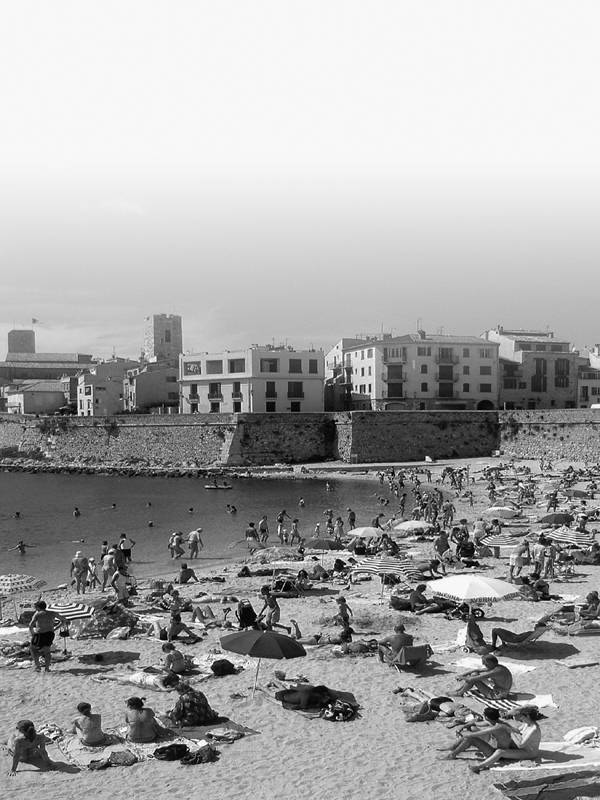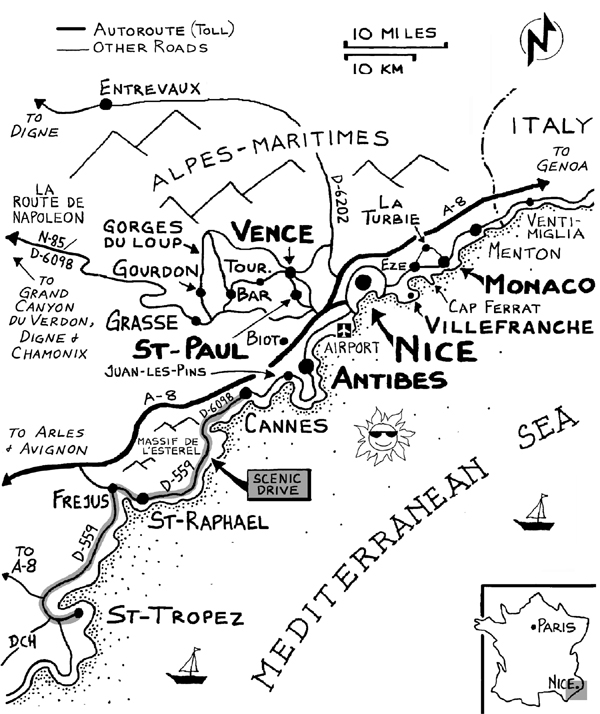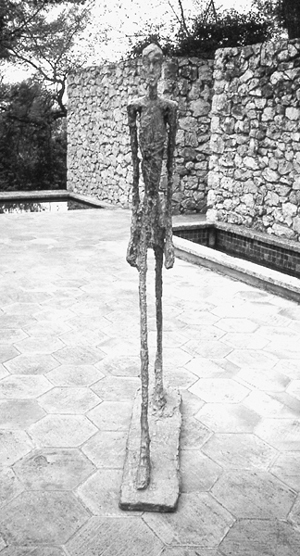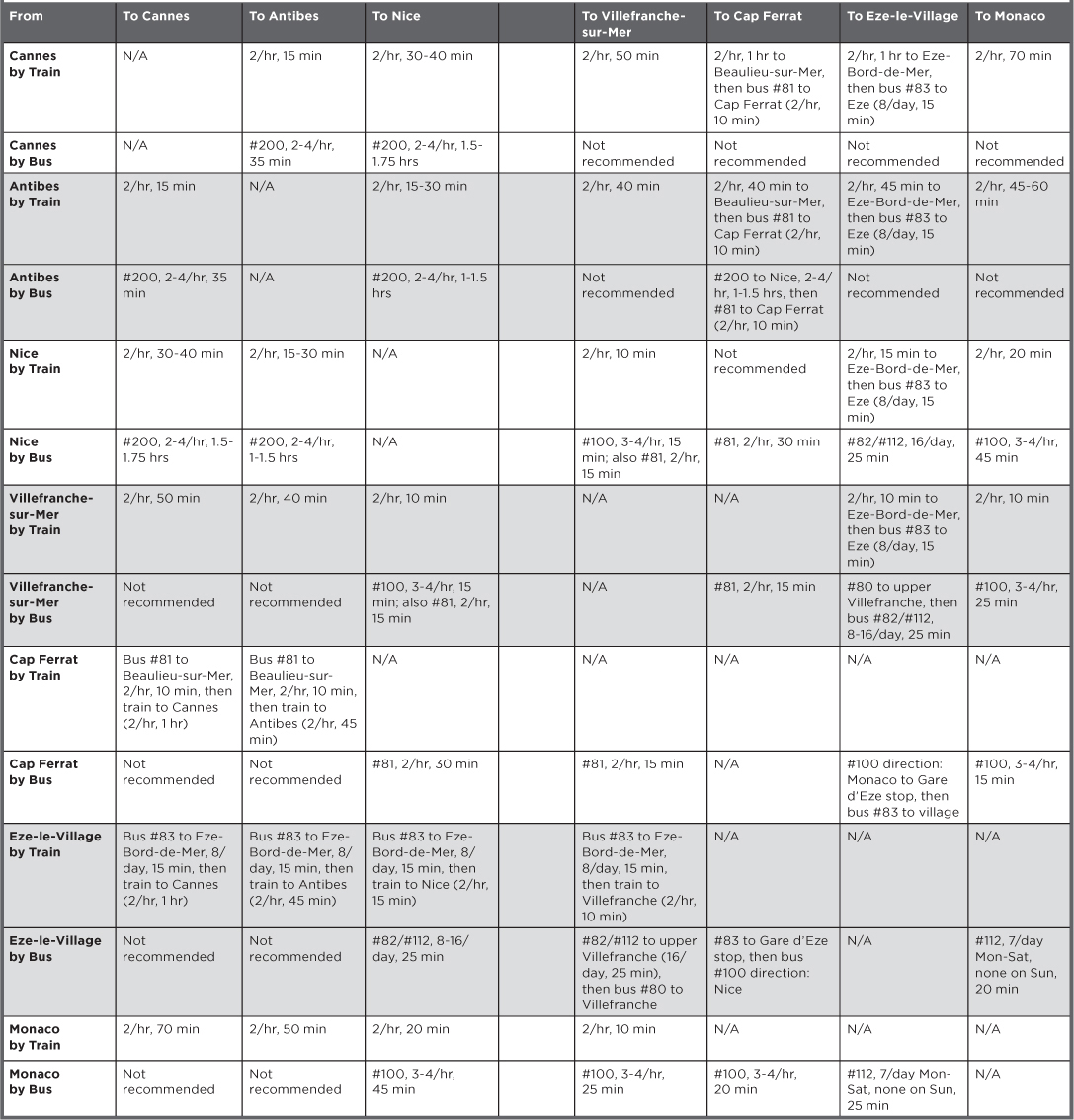

La Côte d’Azur
A hundred years ago, celebrities from London to Moscow flocked to the French Riviera to socialize, gamble, and escape the dreary weather at home. Today, budget vacationers and heat-seeking Europeans fill belle-époque resorts at France’s most sought-after fun-in-the-sun destination.
The region got its nickname from turn-of-the-20th-century vacationing Brits, who simply extended the Italian Riviera west to France to include Nice. Today, the Riviera label stretches even farther westward, running (for our purposes) from the Italian border to St-Tropez. To the French, this summer fun zone is known as La Côte d’Azur. All my French Riviera destinations are on the sea, except for a few hill towns and the Gorges du Verdon.
This sunny sliver of land has been inhabited for more than 3,000 years. Ligurians were first, then Greeks, then Romans—who, as usual, had the greatest impact. After the fall of Rome, Nice became an important city in the Kingdom of Provence (along with Marseille and Arles). In the 14th century Nice’s leaders voted to throw their beach towel in with the duke of Savoy’s mountainous kingdom (also including several regions of northern Italy), which would later evolve into the Kingdom of Sardinia. It was not until 1860 that Nice (and Savoy) became a part of France—the result of a citywide vote made possible by Napoleon III and the king of Sardinia.
Nice has world-class museums, a splendid beachfront promenade, a seductive old town, and all the drawbacks of a major city (traffic, crime, pollution, and so on). The day-trip possibilities are easy and exciting: Monte Carlo welcomes everyone and will happily take your cash; Antibes has a thriving port and silky sand beaches; and image-conscious Cannes is the Riviera’s self-appointed queen, with an elegant veneer hiding...very little. Yacht-happy St-Tropez swims alone an hour west (halfway to Cassis and Marseille). The Riviera’s overlooked interior transports travelers to a world apart, with cliff-hanging villages, impossibly steep canyons, and alpine scenery—a refreshing alternative to the beach scene.

My favorite home bases are Nice, Antibes, and Villefranche-sur-Mer.
Nice is the region’s capital and France’s fifth-largest city. With convenient train and bus connections to most regional sights, this is the most practical base for train travelers. Urban Nice also has a full palette of museums (most of which are free), a beach scene that rocks, the best selection of hotels in all price ranges, and good nightlife options. A car is a headache in Nice, though it’s easily stored at one of the many pricey parking garages or for free at an outer tram station.
Nearby Antibes is smaller, with a bustling center, a lively night scene, great sandy beaches, grand vistas, good walking trails, and a much-admired Picasso Museum. Antibes has frequent train service to Nice and Monaco, and quick connections by train or car to Grasse. It’s also an easy place for drivers, with light traffic and easy hotel parking.
Villefranche-sur-Mer is the romantic’s choice, with a serene setting and small-town warmth. It has finely ground pebble beaches; quick public transportation to Nice, Monaco, and Cap Ferrat; easy parking; and a small selection of hotels in most price ranges.
Ideally, allow a day and a half for Nice itself, an afternoon to explore inland hill towns, a day for Italianesque Villefranche-sur-Mer and lovely Cap Ferrat, a day for Monaco and the Corniches, and—if time allows—a day for Antibes and Cannes. Consider using two different Riviera bases, and enjoy each for a couple of nights—Villefranche-sur-Mer pairs well with Antibes or Nice. And if you must do St-Tropez, visit it while traveling to or from destinations farther west (such as Cassis, Aix-en-Provence, and Arles) and avoid it on weekend afternoons, as well as all summer.
Monaco has a unique energy at night, and Antibes works well by day (good beaches and hiking) and night (fine choice of restaurants and a lively after-hours scene). Hill town-loving naturalists should add a night or two inland to explore the charming hill-capping hamlets near Vence.
Depending on the amount of time you have in the Riviera, here are my recommended priorities:

Medical Help: Riviera Medical Services has a list of English-speaking physicians all along the Riviera. They can help you make an appointment or call an ambulance (tel. 04 93 26 12 70, www.rivieramedical.com).
Closed Days: The following sights are closed on Mondays: the Modern and Contemporary Art Museum, the Fine Arts Museum, and the cours Saleya market in Nice, along with Antibes’ Marché Provençal market (Sept-May). On Tuesdays the Chagall, Matisse, and Archaeological museums in Nice are closed (Matisse Museum may close in 2012 for renovation).
Events: The Riviera is famous for staging major events. Unless you’re actually taking part in the festivities, these occasions give you only room shortages and traffic jams. Here are the three biggies: Nice Carnival (Feb 17-March 4 in 2012, Feb 22-March 10 in 2013, www.nicecarnaval.com), Grand Prix of Monaco (May 24-27 in 2012, May 23-26 in 2013, www.acm.mc), and Festival de Cannes, better known as the Cannes Film Festival (May 16-27 in 2012, www.festival-cannes.com).
Local Guides: Sylvie Di Cristo offers terrific full-day tours throughout the French Riviera in a car or minivan. She adores educating people about this area’s culture and history, and loves adapting her tour to your interests, from overlooked hill towns to wine, cuisine, art, or perfume (€200/person for 2-3 people, €130-150/person for 4-6 people, €90/person for 7-8 people, 2-person minimum, mobile 06 09 88 83 83, www.frenchrivieraguides.net, dicristosylvie@gmail.com). Sofia Villavicencio is a young, sweet guide with a passion for art (€135/half-day, €200/full-day, tel. 04 93 32 45 92, mobile 06 68 51 55 52, sofia.villavicencio@laposte.net).
Minivan Tours: The TI and most hotels have information on minivan excursions from Nice (roughly €50-60/half-day, €80-110/day). Revelation Tours takes pride in its guides (tel. 04 93 53 69 85, www.revelation-tours.com). Med-Tour is one of many (tel. 04 93 82 92 58, mobile 06 73 82 04 10, www.med-tour.com); Tour Azur is another (tel. 04 93 44 88 77, www.tourazur.com). All also offer private tours by the day or half-day (check with them for their outrageous prices, about €90/hour).
Cruise-Ship Sightseeing: The French Riviera is a popular cruise destination. Arriving ships are divided about evenly between three ports: Nice, Villefranche-sur-Mer, and Monaco. I’ve provided arrival instructions in the “Connections” section at the end of each of those destination chapters. Because these three ports line up conveniently along a 10-mile stretch of coast—easily connected by train or bus—from any of them, you’ll have the Riviera by the tail. Consider hiring a local guide to help make the most of your limited time (listed above). A few smaller ships also call at Cannes, farther west. If your cruise includes destinations beyond the French Riviera, consider my guidebook, Rick Steves’ Mediterranean Cruise Ports.
By Public Transportation: Trains and buses do a good job of connecting places along the coast, with bonus views along many routes. Buses also provide reasonable service to some inland hill towns. Choose the bus for convenience and economy, or the pricier but faster train when you want to save time. Whichever way you go, carry plenty of change to buy train tickets from machines at smaller, unstaffed stations and to buy bus tickets from drivers (who can’t make change for large bills).
See “Public Transportation in the French Riviera”
Buses are an amazing deal. The Côte d’Azur has one regional bus network—Lignes d’Azur (www.lignesdazur.com). Any one-way ride costs €1 (except on express airport buses), whether you’re riding 15 minutes to Villefranche-sur-Mer, 45 minutes to Monaco, or an hour to Antibes. The €1 ticket is good for 74 minutes of travel in one direction anywhere within the bus system (can’t be used for a round-trip). Buy your ticket from the driver, and validate your ticket in the machine on the bus. You can even transfer between the buses of the Lignes d’Azur and the smaller TAM (Transports Alpes-Maritimes) system; if you board a TAM bus and need a transfer, ask for un ticket correspondance. A €4 all-day ticket is good on Nice’s city buses, tramway, and airport express bus, plus selected buses serving nearby destinations (such as Villefranche, Cap Ferrat, and Eze-le-Village).
The train is more expensive, but there’s no quicker way to move about the Riviera (www.sncf.com). Speedy trains link the Riviera’s beachfront destinations—Cannes, Antibes, Nice, Villefranche-sur-Mer, Monaco, Menton, and the inland perfume town of Grasse. Never board a train without a ticket or valid pass—fare inspectors don’t accept any excuses, and the minimum fine is €70.
Nice makes the most convenient base for day trips, though public transport also works well from smaller Riviera towns such as Antibes and Villefranche-sur-Mer. St-Tropez is remote, requiring a bus or boat connection. Details are provided under each destination’s “Connections” section. For a scenic inland train ride, take the narrow-gauge train into the Alps (see here).
And a final tip: No matter where you go, bring along a swimsuit if the weather’s sunny—good beaches are plentiful.
For an overview of many Riviera train and bus connections, see the “Public Transportation in the French Riviera” chart above. The bus frequencies given are for Monday-Saturday (Sunday often has limited or no bus service)—confirm all connections and last train/bus times locally. I’ve listed some connections as “not recommended” due to the amount of time spent in transit and/or the number of transfers required.
By Car: After Paris, this is France’s most challenging region to drive in. Beautifully distracting vistas (natural and human), loads of Sunday-driver tourists, and an overabundance of cars make for a dangerous combination; pay extra attention while driving down here. Parking can be tricky for the same reasons, so have patience and consider using buses or trains. Have lots of coins ready for parking and for autoroute tolls.
The Riviera is awash with scenic roads. To sample some of the Riviera’s best scenery, drivers should find the splendid coastal road between Cannes and Fréjus (D-6098 from Cannes/D-559 from Fréjus), which works well when connecting the Riviera with Provence. If it weren’t for the Mediterranean sea below, you’d swear you were in Arizona (in Fréjus, follow signs to Centre-Ville, then Cannes par la Bord de la Mer; from Cannes, drive to the western end of town and follow La Napoule signs to reach the road).
Drivers should also scour the three coastal roads—called “corniches”—between Nice and Monaco (see here) and take my recommended inland hill-towns drive (on here). Farther inland, the Grand Canyon du Verdon patiently awaits, with breathtaking gorges and alpine scenery. But even if you have a car, consider the convenience that trains and buses offer for basic sightseeing between Monaco and Cannes.
By Boat: Trans Côte d’Azur offers boat service from Nice to Monaco or to St-Tropez from June into September, as well as between Cannes and St-Tropez (tel. 04 92 98 71 30, www.trans-cote-azur.com). For details, see “Getting Around the Riviera from Nice” (here).
The list of artists who have painted the Riviera reads like a Who’s Who of 20th-century art. Pierre-Auguste Renoir, Henri Matisse, Marc Chagall, Georges Braque, Raoul Dufy, Fernand Léger, and Pablo Picasso all lived and worked here—and raved about the region’s wonderful light. Their simple, semi-abstract, and—most importantly—colorful works reflect the pleasurable atmosphere of the Riviera. You’ll experience the same landscapes they painted in this bright, sun-drenched region, punctuated with views of the “azure sea.” Try to imagine the Riviera with a fraction of the people and development you see today.

But the artists were mostly drawn to the uncomplicated lifestyle of fishermen and farmers that has reigned here since time began. As the artists grew older, they retired in the sun, turned their backs on modern art’s “isms,” and painted with the wide-eyed wonder of children, using bright primary colors, basic outlines, and simple subjects.
A dynamic concentration of well-organized modern- and contemporary-art museums (many described in this book) litter the Riviera, allowing art-lovers to appreciate these masters’ works while immersed in the same sun and culture that inspired them. Many of the museums were designed to blend pieces with the surrounding views, gardens, and fountains, thus highlighting that modern art is not only stimulating, but sometimes simply beautiful.
Entire books have been written about the modern-art galleries of the Riviera. If you’re a fan, do some studying before your visit to be sure you know about that far-out museum of your dreams. Even if you aren’t usually turned on by modern art, take the opportunity to experience the region’s brilliant display of it by visiting the Fondation Maeght in St-Paul-de-Vence, and the Chagall and Matisse museums in Nice.
See “Top Art Sights of the Riviera”
The Riviera adds an Italian-Mediterranean flair to the food of Provence. While many of the same dishes served in Provence are available throughout the Riviera (see “Provence’s Cuisine Scene” on here), there are differences, especially if you look for anything Italian or from the sea. The proximity to the water and historic ties to Italy are clear in this region’s dishes.
La salade niçoise is where most Riviera meals start. A true specialty from Nice, this salad has many versions, though most include a base of green salad topped with green beans, boiled potatoes (sometimes rice), tomatoes (sometimes corn), anchovies, olives, hard-boiled eggs, and lots of tuna. Every café and restaurant adds its own twist to this filling dish that goes down well on sultry days.
For lunch on the go, look for a pan bagnat (like a salade niçoise stuffed into a hollowed-out soft roll). Other tasty bread treats include pissaladière (bread dough topped with onions, olives, and anchovies), fougasse (a spindly, lace-like bread sometimes flavored with nuts, herbs, olives, or ham), and socca (a thin chickpea crêpe, seasoned with pepper and olive oil and often served in a paper cone by street vendors).
Invented in Nice, ravioli and potato gnocchi can be found on menus everywhere (ravioli can be stuffed with a variety of fillings, but it’s best with seafood). Thin-crust pizza and pâtes fraîches (fresh pasta) are generally a good value throughout the Riviera.
Bouillabaisse is the Riviera’s most famous dish; look for it in any seafront village or city. It’s a spicy fish stew based on recipes handed down from sailors in Marseille. It must contain at least four types of fresh fish, though most have five to twelve kinds. A true bouillabaisse never has shellfish. The fish—cooked in a tomato-based stock and flavored with saffron (and sometimes anise and orange)—is separated from the stock before serving. The cook then heightens the flavor of the stock by adding toasted croutons and a dollop of rouille sauce (a thickened reddish mayonnaise heady with garlic and spicy peppers). This dish often requires a minimum order of two and can cost up to €40-60 per person.
Those on a budget can enjoy other seafood soups and stews. Far less pricey than bouillabaisse and worth trying is the local soupe de poisson (fish soup). It’s a creamy soup flavored like bouillabaisse, with anise and orange, and served with croutons and rouille sauce (but has no chunks of fish). For a less colorful but still tasty soup, look for bourride, a creamy fish concoction thickened with an aioli sauce instead of the red rouille; or baudroie, a fishy soup cooked with vegetables and garlic.
The Riviera specializes in all sorts of fish and shellfish. Other options include fruits de mer, or platters of seafood (including tiny shellfish, from which you get the edible part only by sucking really hard); herb-infused mussels; stuffed sardines; squid (slowly simmered with tomatoes and herbs); and tuna (thon). The popular loup flambé au fenouil is grilled sea bass, flavored with fennel and torched with pastis prior to serving.
Cheese and dessert dishes of the Riviera are indistinguishable from those in Provence. Refer to “Provence’s Cuisine Scene” (here) for suggestions.
You’re better off avoiding fixed-price menus at most places and just ordering a first course and a main course, or a main course and dessert. I prefer licking my dessert on an after-dinner waterfront stroll (works great in all three home bases I recommend).
Unfortunately, memorable restaurants that showcase the Riviera’s cuisine are more difficult to find than in neighboring Provence. Because most visitors come more for the sun than the food, and because the clientele is predominantly international, many restaurants aim for the middle and are hard to tell apart. When dining on the Riviera, I look for views and ambience more than top-quality cuisine.
Do as everyone else does: Drink wines from Provence. Bandol (red) and cassis (white) are popular and from a region nearly on the Riviera. The only wines made in the Riviera are Bellet rosé and white, the latter often found in fish-shaped bottles. For more on Provençal wine, see here.

These are listed in order of importance.
Fondation Maeght (St-Paul-de-Vence)
Chagall Museum (Nice)
Picasso Museum (Antibes)
Matisse Museum (Nice)
Museum of the Annonciade (St-Tropez)
Chapel of the Rosary (Vence)
Modern and Contemporary Art Museum (Nice)
Renoir Museum (Cagnes-sur-Mer)
Fine Arts Museum (Nice)